After seven successful years, one of the World Organisation for Animal Health’s flagship projects, EBO-SURSY, is coming to a close. Highlighting its significant impact on animal health, the project has produced a final impact report underscoring its commitment to improving everyone’s health. The primary focus of this EU-funded program has been on the protection of wildlife health, and the health of the human communities who live beside them.
Partnered closely with ten countries in West and Central Africa, the project applied a One Health approach, strengthening national and regional early detection systems for zoonotic wildlife diseases. By improving ways to detect and prepare for outbreaks of viral haemorrhagic fevers like Ebola and Lassa fever, the EBO-SURSY Project has helped build a healthier world for animals and humans alike.
Empowering the animal health workforce
A key component in strengthening a health system is investing in personnel. Without technical knowledge, techniques, material, or resources to excel in their profession, staff cannot thrive and perform to their best ability. To bridge these gaps, the
EBO-SURSY Project hosted a wide range of capacity-building activities, including training programmes and scholarships. It gave animal and human health stakeholders all along the chain the means to build robust surveillance systems in their countries, which will encourage long-term, positive impacts.
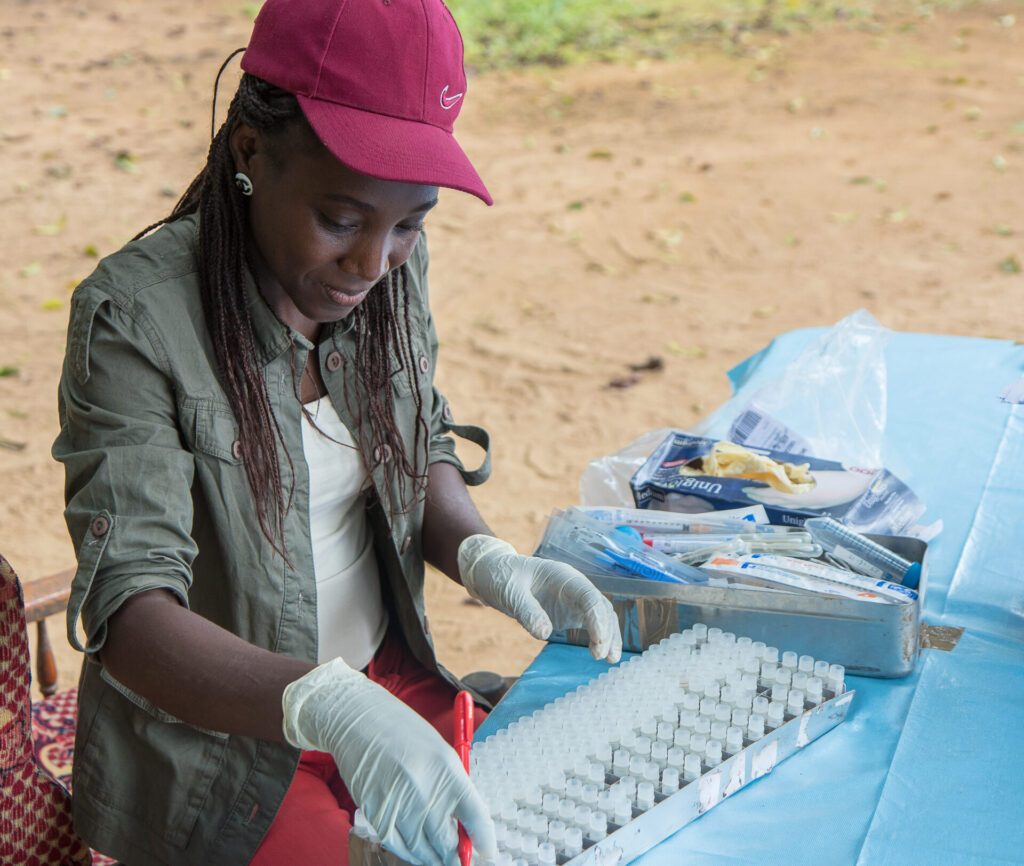
In addition, the project has also given stakeholders the opportunity to network and build relationships across the One Health spectrum, including animal, human, wildlife, or environmental health professionals. These strengthened relationships are the backbone of a comprehensive health system.
700+
professionals and students trained in laboratory techniques, ecology, epidemiology and surveillance systems
600
health professionals engaged in improved intersectoral collaboration
30
educational grants provided to health professionals to attend One Health and emerging diseases training
Building trust with communities
Because of zoonotic spillover, humans and wildlife alike are increasingly vulnerable to many diseases such as viral haemorrhagic fevers. People living near or within natural ecosystems such as rainforests are generally isolated and lack access to information on how to safeguard themselves, wildlife and domestic animals.
Informed communities are empowered to protect themselves, other humans and wildlife, and EBO-SURSY was committed to building their knowledge. By looking out for tell-tale signs of zoonoses, including unusual deaths and behaviour in wildlife, local communities are the first in line to alert national Veterinary Services or wildlife authorities.
The EBO-SURSY Project, in partnership with local journalists and youth reporters, reached out to communities through radio campaigns focused on raising awareness on wildlife diseases and prevention strategies.
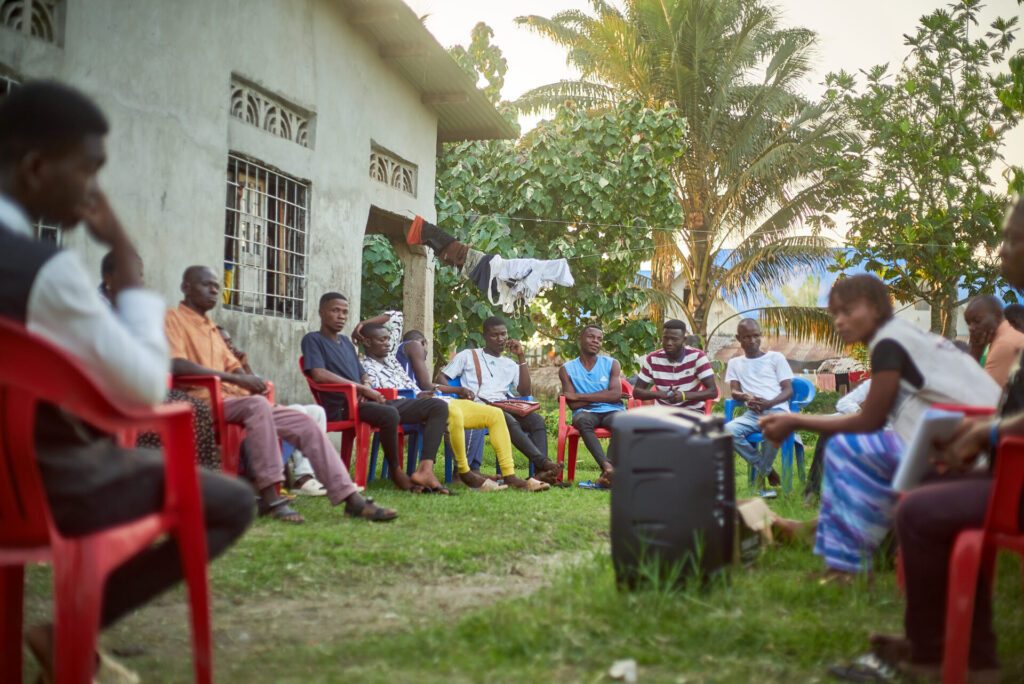
Overall the efforts of the project led to:
reaching over
3 million
listeners in Guinea and DRC with life saving information
the development and broadcasting of over
2,400
public service announcements
the training of over
60
radio broadcasters, journalists and youth reporters on reporting animal health issues
Predicting and preventing outbreaks
Building capacity and raising community awareness are essential steps in establishing strong national surveillance systems, but they are not enough. It’s imperative for countries to implement plans to monitor pathogens and provide clear, accessible guidance for both professionals and the public during an outbreak.
To empower national Veterinary Services and wildlife professionals build effective surveillance protocols step-by-step, the EBO-SURSY Project held several regional workshops. Some attendee countries went further, holding national-level workshops with EBO-SURSY support, to refine their draft protocols for priority diseases and to gain national support to pass them into legislation.
True to the project’s nature, a holistic approach involving professionals from across the One Health spectrum was adopted throughout
- Sierra Leone, Republic of Congo and the Central African Republic adopted national multisectoral Rift Valley fever surveillance protocols.
- Ivory Coast has one on Lassa fever
- 10 countries now have experience building surveillance protocols, which can be applied to other diseases in the future.
- Other countries that attended the workshops made great progress in developing protocols which may be implemented in the future.
Because efficient surveillance protocols must be grounded in scientific fact, the
EBO-SURSY Project was committed to scientific research on key viral haemorrhagic fever diseases. It organised field investigations and supported multi-scale research through its consortium partners, Le Centre de coopération internationale en recherche agronomique pour le développement (CIRAD), Institut de recherche pour le développement (IRD) and Institut Pasteur.
All three are known for their scientific excellence in the prevention and control of zoonoses, and worked with local stakeholders in the project countries with the aim of providing data-driven predictive models and risk assessment tools.
- 197 field investigations to support scientific research of 5 viral haemorrhagic fevers, coronavirus, monkeypox and more.
- 43,000 animal samples and 6,000 human samples taken to track diseases at the animal-human interface and improve scientific studies.
- 43 scientific studies were published as a result of EBO-SURSY funded research in the fields of ecology, genetics and socio-economics.
- 25 methodologies and diagnostic tools have been improved or developed.
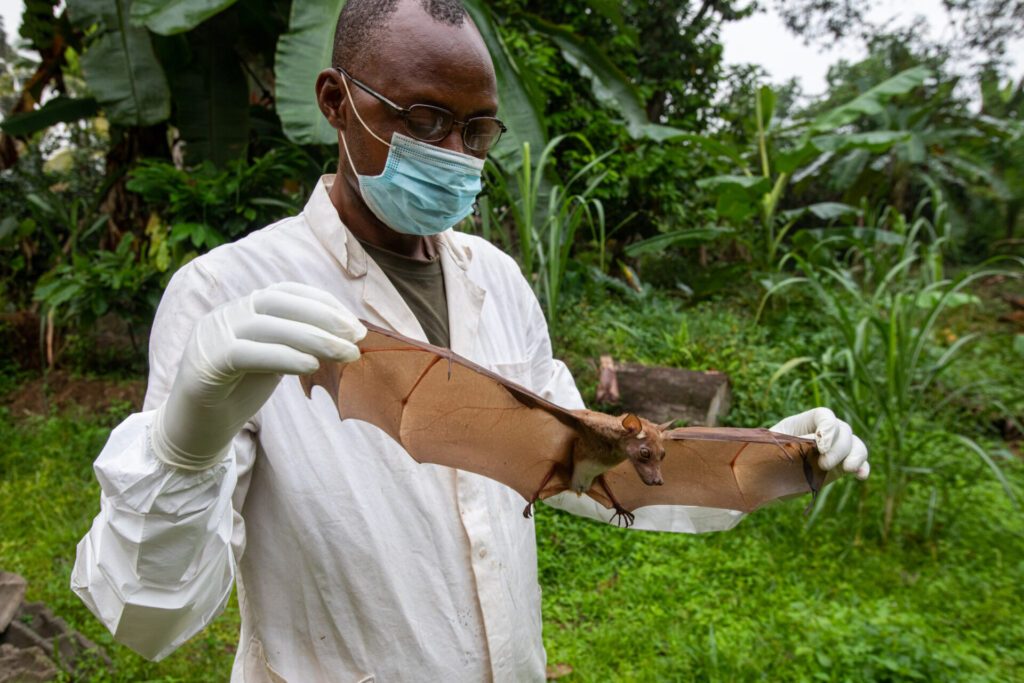
A new future for wildlife health
As the EBO-SURSY Project concludes its commitments this year, it is about to enter a new phase with the support of the European Union.
Over the next years, it aims to expand its geographic scope to 17 countries and include more scientific partners, as well as additional One Health stakeholders. The project will go even further in helping national Veterinary Services set up efficient surveillance systems, and apply scientific findings from phase one into policy, legislation, and professional guidance to safeguard health.
More information
-
EBO-SURSY Impact Report: Protecting wildlife, protecting our future
-
EBO-SURSY Project website
In South-East Asia, the topic of Antimicrobial resistance (AMR) is seldom covered by the Indonesian media due to a knowledge gap among journalists and editors, hindering the dissemination of critical information. To address this issue, WOAH trained more than 40 media personnel in Surabaya, Indonesia.
AMR is often referred to as a “silent pandemic”. Despite its profound consequences for human, animal, and environmental health, AMR remains largely unfamiliar to non-expert audiences. Raising awareness and advocacy are essential tools to mitigate AMR as they can lead to changing risky behaviours among different stakeholders. In this context, professionals in the field of animal health are often the target audience for information, education, and communication materials, as well as awareness-raising activities. Additionally, Veterinary Services regularly advocate for the implementation of guidelines to promote the responsible use of antimicrobials targeting farming communities, veterinarians, and pharmacists. Yet, it is uncommon for trustworthy information on AMR to successfully reach a wider audience, meaning consumers or pet owners.
Low Visibility of AMR in Mass Media
Communicating about AMR in mass media poses several challenges in South-East Asia due to the prevalence of other pressing topics, such as animal diseases, that capture more attention. For instance, African swine fever and foot and mouth disease have serious consequences on international trade and local economies, while rabies can lead to human deaths. Journalists can easily work on stories about these topics by selecting different approaches to attract a large audience. However, AMR consequences do not occur following a particular event or outbreak that is traceable but are rather the result of constant bad practices in different sectors, which could be considered less newsworthy.
Engaging the media is essential for raising awareness since articles, interviews and other content formats can shape public perception, policies, and stakeholder engagement on a particular issue. Yet, in South-East Asia, journalists face challenges in developing expertise on complex issues such as AMR due to time constraints. Additionally, limited knowledge, competing interests and editorial choices also restrict their opportunities to conduct research on AMR.
Addressing the Knowledge Gap in Indonesian Media
To address these challenges and increase the level of public awareness on AMR, WOAH conducted media engagement activities in Indonesia in May 2023. Around 40 journalists participated in the first edition of the media training organised in Jakarta in the framework of the Multi-Partner Trust Fund (MPTF) project and in cooperation with the largest Indonesian association of independent journalists (AJI). Nearly all the participants admitted their lack of knowledge or total unfamiliarity with what AMR entails. However, they also unanimously recognised the potential success of communicating about AMR and, shortly after the training, published articles related to AMR in mass media.
A second training was organised in Surabaya, the main city of East-Java Province of Indonesia, under the support of UK Fleming Fund in order to extend the training to journalists based at provincial level. These professionals usually face several challenges in terms of access to information and resources, which are barriers to prioritise science communications. Due to these constraints, AMR was not adequately covered or rather not covered at all in East-Java. Additionally, several poultry farms are located in this province, making it a relevant choice to engage local farmers. The socio-economic context could also contribute to raising interest in AMR since the consumption of chicken is very high in this area.
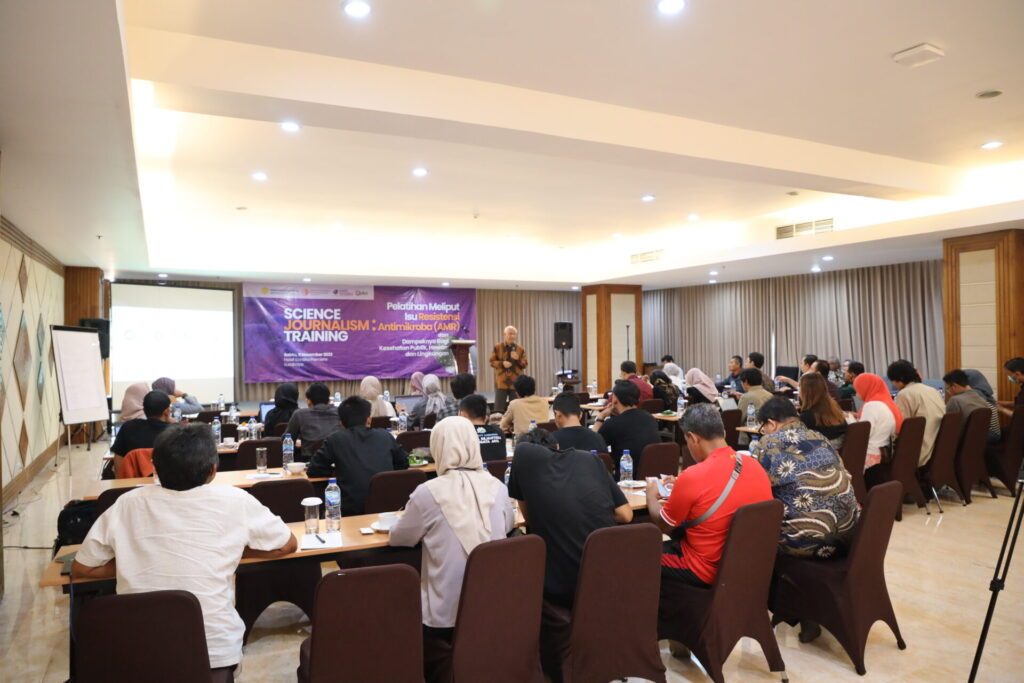
Scientific Journalism: A Rigorous Approach to fighting AMR in Indonesia
The second training was attended by 42 journalists, with diverse roles in the media from reporters to managing directors, content writers, and editors. The training provided an overview of the current AMR situation in Indonesia and introduced the One Health approach to mitigate this global health threat. A well-known journalist addressed the methodology needed to report on science-based facts, highlighting key principles:
- Accuracy: scientific information should be conveyed without distorting the findings or misrepresenting the research
- Clarity: scientific content should be clear and comprehensible to a general audience to form their opinion
- Relevance: scientific evidence should be connected to everyday experiences to make the information more engaging
The COVID-19 pandemic was used as a case study to learn from the experience of this health crisis, when media statements in Indonesia were not always based on scientific evidence, misleading the general public. To avoid the dissemination of fake news, journalists were recommended to cross-check information by consulting academic journals, interviewing several experts and, in case of conflicting analysis, presenting the facts to allow the audience to form its own opinion.
Publication on AMR in Provincial and Local Media
The outcomes of the training were assessed to better understand how journalists benefited from this activity showing encouraging results as over 250 publications on AMR were issued in the mass media (TV, online newspapers, radio, etc.).
As highlighted by the results of this activity led by WOAH, while media engagement requires a lot of effort, it can also present great opportunities to raise awareness on responsible antimicrobial use among non-technical audiences. This will help increase the visibility of this “silent pandemic”, which is already responsible for over 4 million human deaths per year.
More information
-
Antimicrobial Resistance
The Global Burden of Animal Diseases (GBADs) is a groundbreaking programme with a mission to help Veterinary Services, and their investors, to decide where to focus the allocation of resources for animal health at the local, national, and global levels.
Spearheaded by the World Organisation for Animal Health (WOAH) and the University of Liverpool and implemented by a consortium of research institutions and international organisations, GBADs measures and quantifies economic loss due to animal health issues at the farm and wider societal levels and provides essential information on where the losses occur, to whom and the causes and risk factors. The ongoing GBADs proof-of-concept case study in Ethiopia is revealing invaluable insights into the significant impact of animal diseases on the nation’s economy and the urgent need for further resources to address this pressing issue.
Ethiopia’s thriving livestock landscape
Ethiopia was identified for the case study due to its significant livestock sector, which plays a critical role in supporting cropping activities, human nutrition, and international trade. Livestock production contributes to nearly 20% of Ethiopian GDP, making it an important component of the country’s economy. However, despite its economic importance, the livestock sector faces the persistent challenge of animal disease burdens that result in substantial losses for both producers and society.
To systematically and robustly measure these losses, Ethiopia signed on to pilot the GBADs programme.
The study aimed to provide essential data to guide the development of evidence-based animal health policies that align with Ethiopia’s national livestock development goals. To accomplish this, established and novel methodologies were employed to estimate the economic losses caused by suboptimal animal health. The study is led by the International Livestock Research Institute (ILRI) and is advised by the National Steering Committee for the case study, chaired by the Ministry of Livestock, including representatives from the private sector such as the Ethiopia Veterinary Association and EthioChicken, and academia.
The country’s active involvement has been instrumental in shaping the programme’s success, and we are proud to contribute to the collective effort of improving animal health on a global scale.
Dr Wubishet Zewde Wakene, Lead Executive of Disease Prevention and Veterinary Public Health, Ethiopia Ministry of Agriculture.
GBADs data: from collection to visualisation
Since the start of the case study in January 2021, the GBADs Ethiopia team has collected data to trial the GBADs methods to obtain information on animal population and their biomass, the animal health loss envelope, the attribution of the envelope and the impact across the economy. This animal health loss envelope represents the monetary losses resulting from suboptimal animal health.
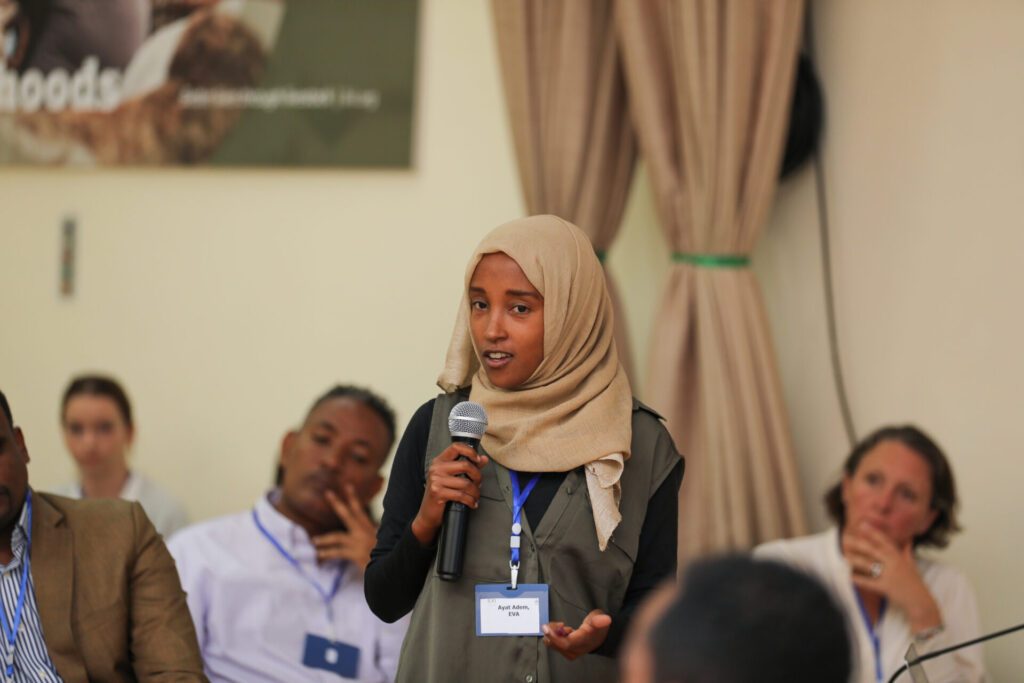
With GBADs, data speaks to you.
Dr Hayet Adem, Board Member, Ethiopia Veterinary Association.
Moreover, the study exposed gender-specific impacts, highlighting that women and girls bear additional burdens due to livestock diseases, including loss of empowerment, well-being, and heightened health risks from zoonotic diseases. While these findings on gender are essential, the lack of quantitative data on these topics calls for more attention and research in future livestock development endeavors.
Ensuring country ownership: building capacity
As the GBADs Ethiopian case study moves forward, the focus expands to encouraging the development of mechanisms to support the adoption and uptake of outputs within end-user institutions, primarily the Ministry of Agriculture and other national research centers. The perceived utility of economic analysis by the Ministry of Agriculture and its close collaboration with the GBADs programme have led to the creation of the first Animal Health Economics Core Group within Veterinary Services in the country, committed to promoting the use of animal health economics to support decision-making at the national level and sub-national level. The GBADs Ethiopia case study team at ILRI has provided mentorship to the Core Group and conducted face-to-face training on animal health economics.
By getting training and support on animal health economics and on data utilisation in addition to integrating GBADs with other livestock management tools and systems, national Veterinary Services will better inform animal health policies and decision-making.
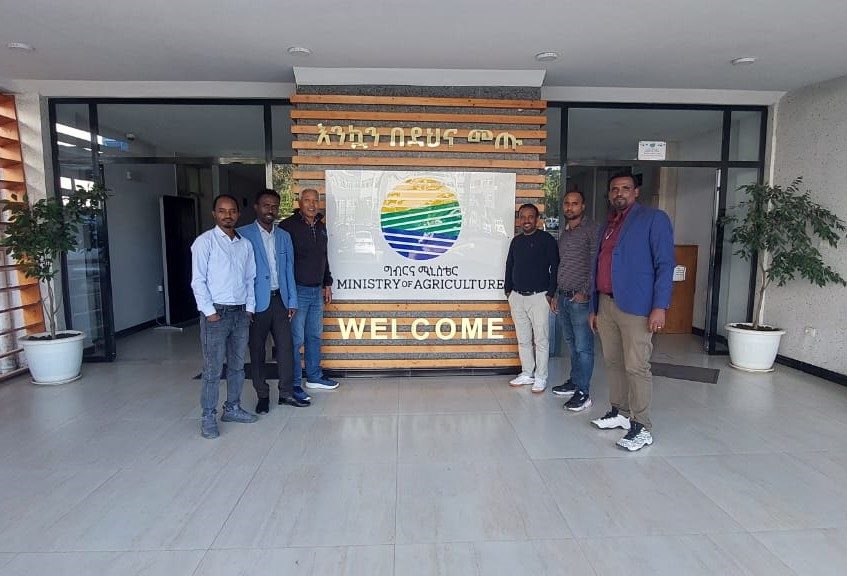
In addition, Veterinary Services are supported in the economics of animal health by the establishment of WOAH Collaborating Centres dedicated to the topic. One was established in 2021 by a consortium of three academic institutes in Europe1 including the University of Liverpool in the United Kingdom, Utrecht University in Netherlands, and the Norwegian Veterinary Institute. This year a centre was established in the Americas2 bringing together Kansas State University and Washington State University in the United States, Universidad Nacional Autonoma De México, University of Brasília and University of São Paulo in Brazil. The establishment of both centres is a strong signal of the interest of GBADs programme to the scientific community aiming at supporting WOAH Members.
1 Consortium of 3 partners: Centre of Excellence for Sustainable Food Systems, Global Burden of Animal Diseases Programme, Institute of Infection, University of Liverpool, UK; Utrecht University, The Netherlands; Norwegian Veterinary Institute – Economics of Animal Health, Norway
2 A consortium of 5 partners: Kansas State University, USA; Universidad Nacional Autonoma De México, Mexico; University of Brasília, Brazil; University of São Paulo, Brazil; & Washington State University, USA
More information
-
Ethiopia case study
-
GBADs: the global burden of animal diseases
On the African continent, radio is still deeply intertwined with community life, reflecting the realities of society and their health concerns. It also remains the most dependable way to deliver messages important to the public, especially in difficult to reach areas. After the resounding success of the first phase of EBO-SURSY Radio (funded by the European Union), the World Organisation for Animal Health (WOAH) committed itself further to the prevention of animal disease outbreaks through educational radio programmes.
Focusing on the Democratic Republic of the Congo (DRC), a country participating in the EBO-SURSY Project, we partnered with Radio Workshop to target those living in forested regions at the animal-human interface, and those likely to eat bushmeat in urban areas. Radio Workshop trained over 30 journalists and youth reporters on zoonotic diseases and how interactions with wildlife can impact human health. With five radio stations in three provinces, the radio partners broadcasted over 2400 messages during four months, conducted over 80 shows, and hosted 12 outreach activities.
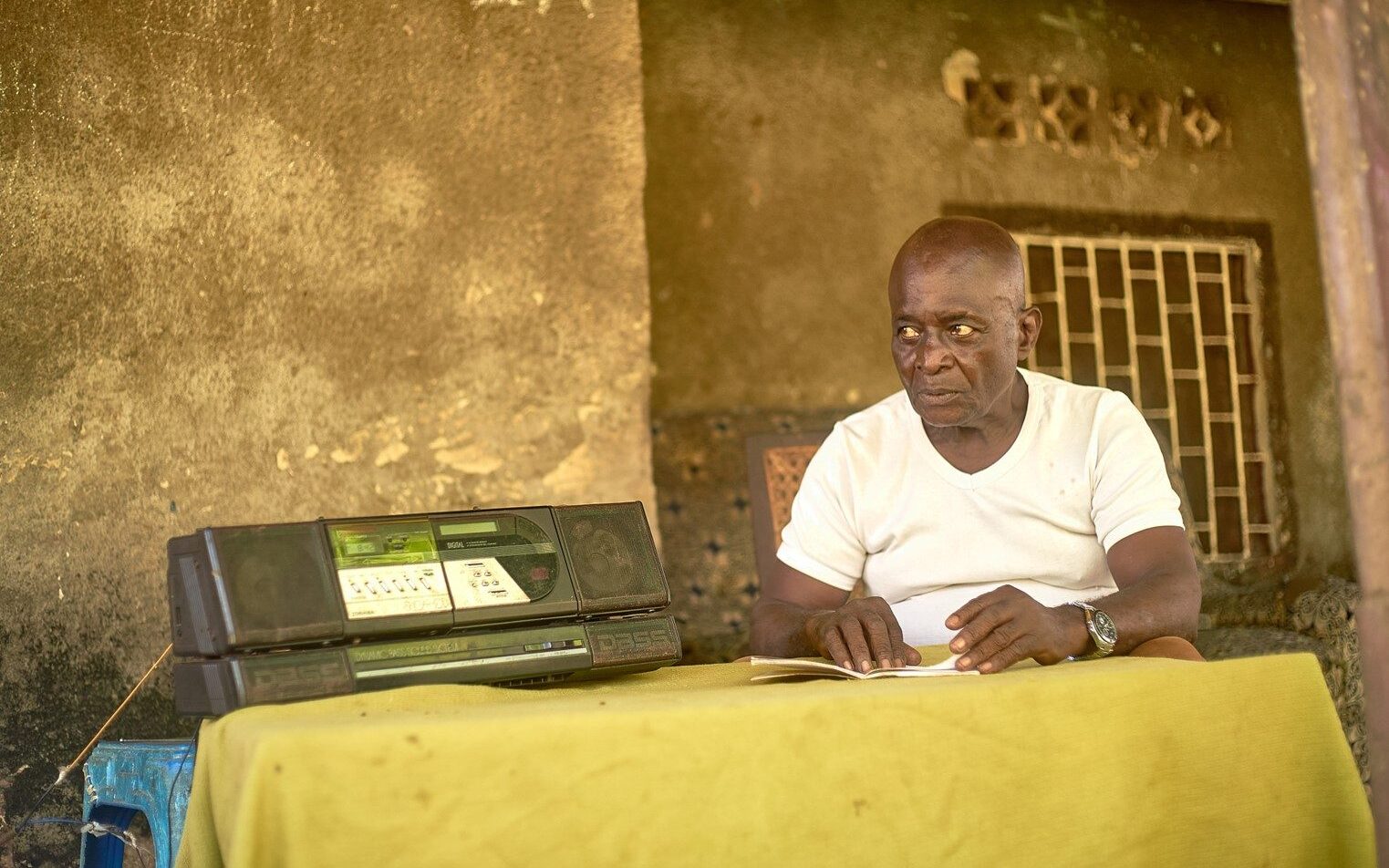
EBO-SURSY Radio proved to be an extremely popular programme with over 2.5 million listeners. It was more popular in rural areas like Mbandaka and Kisangani than in the nation’s capital. In a sample of 601 people interviewed as a part of an evaluation survey, 42% of respondents in Mbandaka and 39% of those in Kisangani indicated they listened to the EBO-SURSY Radio programme, compared to 22% in Kinshasa.
A positive finding was that:
of those indicating they listened to EBO-SURSY Radio were regular listeners and followed the programme several times a week.
of listeners made it a family affair, increasing exposure to critical health lessons to children and the youth.
This demonstrates that radio can provide a special benefit to isolated communities.
Given the importance of this programme, I had to take the decision to buy a larger radio so that my whole family could be educated about zoonoses and learn about the protective measures that need to be put in place to protect ourselves and our environment.
Listener in Yangambi, Democratic Republic of the Congo
Creating capacity for health journalism at the local level
In addition to the benefits of educating families on zoonotic diseases, EBO-SURSY Radio built the capacity of journalists to respond to the health needs of their communities when facing disease outbreaks. The popular Kinshasa radio RTG@ shared that, “EBO-SURSY Radio increased our credibility. With the Monkeypox outbreak, people [said] I heard RTGA talking about it…I’m proud to have been one of the first radio stations in DRC to start raising awareness on this.”
Capitalising on the engagement of radio broadcasters and reporters with EBO-SURSY Radio, the project also created a nation-wide radio competition. Many reporters and broadcasters across the DRC competed for best reportage and for best broadcast, centred on the themes such as One Health, zoonosis, and wildlife surveillance. The judges, each representing one part of One Health, awarded the two winners in a ceremony that included the presence of the Ministry of Livestock. These broadcasts and reportages have the opportunity of being re-aired, ensuring that people all over the nation are exposed to more information on animal health.
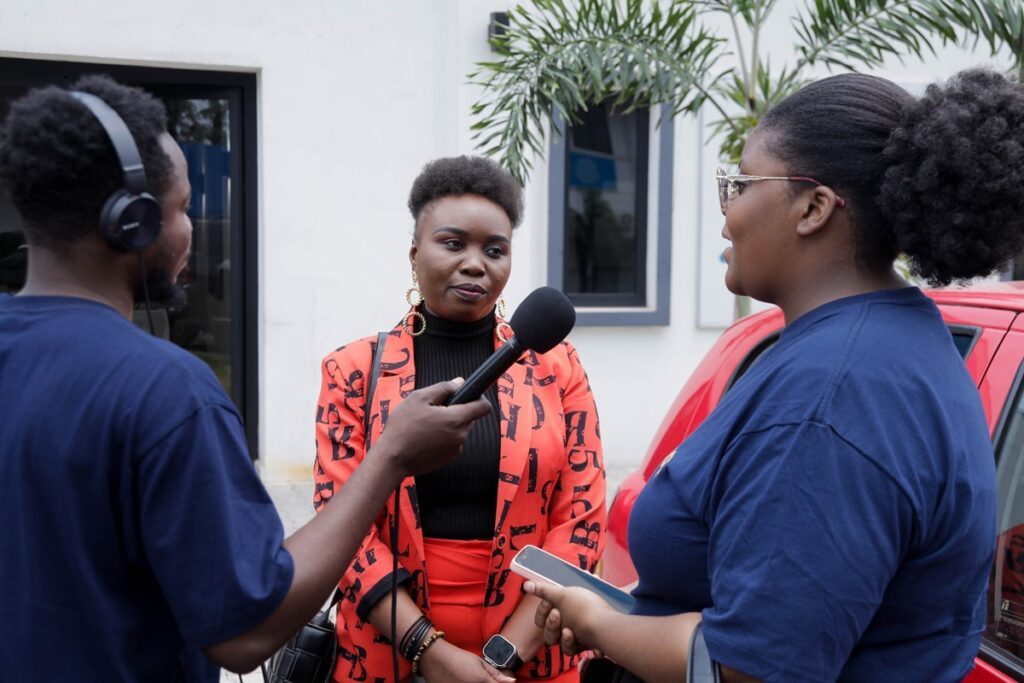
When citizens have the knowledge and confidence to ask more about animal health, it changes the way people consider the interconnection between animals, the environment, and their society. It raises awareness on how people can keep themselves and the wildlife in their community safe, even in remote areas. This is key in places that do not have the reflex to consult animal health experts at all.
Improving community relations with local veterinarians
A primary goal of the World Organisation for Animal Health’s radio programming has been to reinforce the relationship between citizens and their local veterinarians. In the evaluation survey, the results revealed that only 19% of surveyed households in the target communities had consulted a veterinarian in the past six months. Consulting a veterinarian was rarer in the project’s rural villages (7.5%) and in Mbandaka (9%) than in major cities. Rural communities have yet to develop the habit of consulting veterinarians because it is simply hard to find one: the most common reason households who wanted to consult a veterinarian, but did not, was because no veterinarian was present in the community (32%). Even in urban areas however, finding a veterinarian is not easy:
Imagine the [official] slaughterhouse [of a] city, [they] only slaughter three cows a day. That means there is a huge amount of clandestine slaughter… There are slaughter spots in other towns but there is no veterinary control there.
Veterinarian in Democratic Republic of the Congo
Another reason veterinarians were not valued among the surveyed participants was because of a lack of awareness. For 30% of households, they did not see the usefulness of veterinarians, and for 28% of them, expensive fees ensured consulting veterinarians remained out of reach.
Despite these various challenges, EBO-SURSY Radio created a demand for veterinarians in communities where they broadcasted. The results indicated that 42% of those who had consulted veterinarians did not have the habit of doing so before the campaign. Overall, 37% of the total listeners of the programme consulted a veterinarian, in comparison to 11% of non-listeners.
Listeners also emphasised the importance of having creating access to the veterinarians and to the products and solutions they learned about from the EBO-SURSY Radio programme, including vaccination, treatment of sick animals, meat inspection, and general consultations.
Such findings have given insight on how future radio programmes by the World Organisation for Animal Health’s can be focused for the community’s benefits. The more people are aware of how vital veterinarians are for the protection of animal health, as well as for the health of people and the ecosystems around them, the more they will advocate for such services.
Because animal health is our health.
It is everyone’s health.
More information
-
Wildlife Health
-
EBO-SURSY Project page
-
Video: Wildlife health is everyone’s health
In the heart of our changing seasons, a hidden threat emerges, one that poses significant risks to both livestock and human populations. During seasonal movements, animals embark on their journeys in search of water, grazing, or to be traded, an opportunity arises for the spread of transboundary animal diseases (TADs) such as foot and mouth disease, peste des petits ruminants, and Rift Valley fever. The intricate dance of animal migrations across vast landscapes creates a complex tapestry, where diseases find new routes to propagate and thrive.
Livestock, comprising cattle, sheep, goats, and more, become unwitting carriers of these diseases, their movements unknowingly contributing to the dissemination of pathogens. Foot and mouth disease, notorious for its rapid transmission and severe impact on cloven-hoofed animals, takes advantage of this interplay between different species. Peste des petits ruminants, affecting sheep and goats, and Rift Valley fever, with its zoonotic potential, find opportunity in the convergence of animals at shared water points and bustling markets.
The very spaces that enable livelihoods also become channels for contagion. The sight of animals traversing vast landscapes might seem idyllic, yet it masks the invisible menace that these movements facilitate.
The movement of livestock in changing climates and uncertain regions creates a perfect storm for disease transmission.
Dr Néo Mapitse,
Head of the Regional Activities Department,
World Organisation for Animal Health.
As climatic shifts and geopolitical instability alter traditional movement patterns, animals from different regions and health statuses converge in ways that can drastically amplify disease spread.
Amidst this hidden threat, there is hope. By empowering ourselves with knowledge and fostering cooperation, we have the means to protect both our cherished animals and the communities that rely on them. The World Organisation for Animal Health (WOAH) and its dedicated partners are leading the charge to raise awareness about the risks posed by TADs during seasonal pastoral movements.
Prevention and preparedness are our strongest allies in this battle. With timely risk assessments, we can stay ahead of potential outbreaks, enhancing our readiness to counteract disease threats. Increased awareness campaigns among stakeholders and communities ensure that information flows freely, equipping individuals with the tools needed to make informed decisions about livestock during seasonal movements.
Central to this effort is the surveillance of animal gathering points and transit locations. By closely monitoring these key areas, we can swiftly detect any signs of disease and take immediate action, mitigating the chances of further transmission. Additionally, stakeholders’ cooperation during outbreaks is crucial; adherence to movement restrictions and guidelines set by authorities minimises the risk of inadvertently accelerating the spread of diseases.
The changing seasons bring with them a challenge that demands our attention and collaboration. The harmonious movements of livestock across diverse landscapes should not mask the hidden threat of disease propagation. So, let’s unite to safeguard our livestock, preserve our livelihoods, and secure our future. By embracing knowledge, practicing vigilance, and fostering cooperation, we can overcome the challenges presented by transboundary animal diseases during seasonal movements.
Singapore is a city-state in Southeast Asia and the third most densely populated country in the world. At the crossroads of two oceans, the island lacks natural land resources: only 1% of its land is available for agricultural production, which makes the country reliant on international trade for food supply.
Supplying food in Singapore
Despite being one of the world’s leading economic powerhouses, Singapore remains exposed to external and internal challenges. An array of factors, including climate change, global geopolitical tensions, population growth, the scarcity of land available for animal production as well as disease outbreaks and pandemics could endanger its food security. Managing major trade relationships and ensuring that imported animals and animal products are safe and free of animal and zoonotic diseases are therefore crucial in protecting the long-term supply of food of animal origin. Singapore deals with such issues through a One Health approach, with agencies such as the National Parks Board (NParks) and Singapore Food Agency (SFA) to learn, prevent, prepare and respond to cross-sectoral public health threats using an integrated and collaborative approach.
183 countries and regions
in 2022, the number of imported food supply sources by countries and regions stand at 183
42 countries
are allowed to export livestock, meat and egg items to Singapore, having met SFA’s requirements for food safety and animal health
Note: Livestock, meat and egg items are more susceptible to contamination and can lead to foodborne diseases in consumers.
Diversification, a key strategy to ensure Singapore’s food security
With more than 90% of food imported, diversification is a key strategy to ensure Singapore’s food security. SFA continuously works to diversify Singapore’s import sources so that Singaporeans can enjoy a stable supply of safe food.
How do animal diseases threaten food security?
Southeast Asia shows a complex epidemiological landscape, with a recent upsurge of infectious disease outbreaks such as foot-and-mouth disease, classical swine fever, African swine fever and avian influenza ripping through parts of the region. These animal diseases pose a threat to international trade and may jeopardise food security. Livestock diseases often have a toll on animal health and the economy, and it is therefore imperative for national and international regulations to enable their progressive control.
Considering the role that Singapore plays as a major international trading hub and high-end travel destination, the importance of maintaining a disease-free status for major animal diseases takes on special importance. It is therefore a priority that animal diseases are managed before they reach the country’s shores. WOAH international standards propose several alternatives that allow safe international trade, including zoning, compartmentalisation and commodity-based trade. The recognition of compartments by importing partners comes with large benefits but is not an easy task. This makes the experience from Singapore an important one to share.
In a scenario where a disease is present compartmentalisation is particularly relevant. The measure, in fact, allows the functional separation of an animal subpopulation in a limited geographical area from other domestic or wild animals from the same area through biosecurity and management measures. These are two essential components of compartmentalisation that should be developed through cooperation of industry and Veterinary Services. Public-private partnerships play indeed a key role in the successful implementation of compartmentalisation. When adjusted to the identified and monitored risks, biosecurity and management measures prevent disease introduction into the compartment and thus guarantee the maintenance of disease freedom. In this way, trade of animals and animal products from the compartment may be sustained.
Compartmentalisation can grant importing countries and trade partners the needed confidence to assure that commodities derived from a given established compartment are free from specific diseases.
Preserving safe trade in one of the smallest countries in the world
Compartmentalisation provides countries with a tool for continued trade and export of animals and animal products, regardless of the animal health situation of the country or the area in which the compartment is located. Without compartmentalisation, a disease outbreak could result in restrictions to trade from the entire country to many others around the world. This is especially important for a country like Singapore, which relies heavily on international trade.
The case of Singapore illustrates the importance of recognising compartments between trade partners. Dr Kelvin Lim, who serves as Director for Bio risk & Bio-surveillance and the Quarantine & Biosecurity Services at the Animal & Veterinary Service (AVS) under Singapore’s NParks, is acutely aware of the importance of recognising compartments between trade partners.
The recognition of compartments overseas has been giving Singapore the confidence to allow the safe trade of animals and animal products into the country, in line with WOAH’s international standards, while minimising disruption to food supply.
Dr Kelvin Lim, Director for Bio risk & Bio-surveillance and the Quarantine & Biosecurity Services, Animal & Veterinary Service (AVS), Singapore NParks.
“To reap the full benefits of compartmentalisation, Singapore has been actively initiating discussions with major trading partners on the establishment of compartmentalisation arrangements for various diseases, even before the diseases are present in these countries”, Lim adds. “This is because compartmentalisation requires Singapore to make robust assessments of the risks of disease introduction with the import of specific commodities, and we can apply calibrated measures, be it at the exporting farm level or at a border level, to reduce the risk [of disease] introductions. Trading partners should establish parameters and reach agreement on the necessary measures prior to outbreaks of disease”, he explains.
“Having discussions and assessments of compartments conducted during peacetime is naturally more effective and efficient, as compared to conducting them during disease outbreaks, when the exporting country is likely busy combatting them. “This also allows us to appreciate the contingency plans needed in the event of a failure of risk management strategies upstream,” Lim concludes.
Compartmentalisation will continue to remain instrumental for the continuity of imports of animals and products of animal origin. It will help ensure supply of safe food for Singapore and maintain Singapore’s disease-free status whilst protecting animal and public health.
Dr Wong Yelin, Director for Risk Management & Surveillance, Joint Operations Division of the Singapore Food Agency (SFA).
Looking forward, engaging trading partners to have a robust system in place, even before a disease outbreak unfolds, will allow Singapore to keep imports safe despite the challenges ahead.
An interview with Dr William B. Karesh (Member of the Working Group on Wildlife and Executive Vice President for Health and Policy at EcoHealth Alliance).
Briefly, what is El Niño?
William B. Karesh: El Niño means Little Boy in Spanish. South American fishermen first noticed periods of unusually warm water in the Pacific Ocean in the 1600s. The full name they used was El Niño de Navidad, because El Niño typically peaks around December. During normal conditions in the Pacific Ocean, trade winds blow east to west along the equator, taking warm water from South America towards Asia. To replace that warm water, cold water rises from the depths — a process called upwelling. El Niño and La Niña are two opposing climate patterns that break these normal conditions by weakening trade winds. Scientists call these phenomena the El Niño-Southern Oscillation (ENSO) cycle. El Niño and La Niña can both have global impacts on weather patterns, causing extreme environmental events, such as wildfires, with strong societal and economic repercussions on our interdependent ecosystems. Episodes of El Niño and La Niña typically last nine to 12 months but can sometimes last for years. El Niño and La Niña events occur every two to seven years, on average, but they don’t occur on a regular schedule.
In which direct and indirect ways do weather events prompted by
El Niño–Southern Oscillation (ENSO) affect animal health? Which animals are affected the most?
W.B.K: Weather conditions affect animal health both directly with temperature extremes/extreme temperatures and water availability (droughts and floods) as well as indirectly with changes in the availability of nutritional and food resources, abundance of vectors, and crowding, dispersal or movement of animals. The weather extremes may result in dehydration and mal-nutrition in both wild and domestic animals and increases in vector-borne diseases such as Rift Valley fever, yellow fever, and malaria.
Since it occurs on a cyclical basis, should we be able to plan for it? What are the warning signs that ENSO is starting and how much time do we have to prepare?
W.B.K: Using data collected from ocean buoys and satellite systems such as sea temperature, currents, and atmospheric conditions, climate scientists have developed predictive models that can forecast ENSO events with increasing accuracy several months in advance. A key predictive indicator is a shift in Pacific trade winds and a lowering in ocean surface temperatures in the equatorial region of the western Pacific Ocean. While the specific degree and time length of the effects may vary a bit, the general pattern of the changes in different locations remain consistent across/in between ENSO events and thus can be used locally for planning purposes.
What can be done by animal health services and environmental services to be prepared and resilient before an El Niño event?
W.B.K: The first step is to review the impacts of previous ENSO events at the specific local or region level of concern and tailor preparedness and mitigation plans for the anticipated changes such as increased or decreased rainfall. This understanding of the potential impacts can then be used to develop plans that are locally relevant and engage key agencies and community stakeholders in planning and preparedness, as well as design communication strategies for different audiences. Activities may include assuring availability of response equipment and supply stockpiles, refresher training of personnel, planning for water availability or flood control, contingency planning for feed/food availability and supply chains, outbreak or mortality event response capabilities, etc.
How can we support unmanaged wild animal populations during climatic events?
W.B.K: Where droughts are anticipated, access to water may bring livestock and wildlife into closer proximity. This allows for increased disease transmission from livestock to wildlife or to reduce safe access to water by wildlife. Access to water by people, livestock and wildlife can be discussed and planned by engaging relevant stakeholders and relevant authorities. Anticipated changes in ocean temperatures have predictable effects on fish populations and fisheries, and affect food stocks for marine birds and mammals. Fish harvesting quotas should be adjusted to avoid the depletion of fish stocks, and prevent the starvation of wildlife.
What is the Working Group on Wildlife doing to increase awareness of the impacts that extreme events have on wildlife health?
W.B.K: The WGW released an early warning for the coming ENSO event for health authorities and the general public. It stands by to advise WOAH, its Members and other interested parties as requested and as the wildlife situation evolves.
You coined the expression “One Health” in 2003 to describe the interdependence of healthy ecosystems, animals and people. How has this concept evolved in the past twenty years, and what are the accomplishments of the One Health approach that underline its significance today?
W.B.K: The increased attention to ENSO events provides an excellent example of growth of One Health thinking among different sectors that consider how environmental changes can have consequences on health and well-being. The One Health concept has become a starting point for the development of many programs and projects at local, national and international levels to expand cost efficiency and co-benefits. In financial terms, investments in using a One Health approach have exceeded tens of billions (USD) since its inception.
About Dr William B. Karesh
Dr William B. Karesh is the Executive Vice President for Health and Policy at EcoHealth Alliance. He serves as the Chair of the World Organisation for Animal Health (WOAH) Working Group on Wildlife Diseases and also chairs the International Union for the Conservation of Nature (IUCN) Wildlife Health Specialist Group, a network of wildlife and health experts around the world.
Learn more about El Niño
El Nino
How tabletop simulation exercises can build multi-sectoral collaboration and contribute to enhancing resilience against animal health threats.
When it comes to the intentional release of biological agents, informed decisions and prompt action are key to saving animal and human lives. Simulating such events, when the animal health and security sectors come into play, is an effective way to prepare for the future. Exercise Phoenix grew out of this very need. Conducted in February 2023, the simulation exercise provided a platform to build bridges between two seemingly unrelated fields in the face of agro-crime and agro-terrorism.
What happens when these events occur, and what can be done to improve coordination between the actors involved in the response? Delivered by the Food and Agriculture Organization of the United Nations (FAO), the International Criminal Police Organization (INTERPOL) and the World Organisation for Animal Health (WOAH), Exercise Phoenix attempted to answer this question.
The simulation was built around a terrorism scenario targeting animal health and food security in which cooperation between Law Enforcement and Veterinary Services was essential for effective response. Participants from twelve countries were brought together almost simultaneously across three regional hubs located in Amman (Jordan), Bangkok (Thailand) and Hammamet (Tunisia). Players were from the Veterinary Services and Law Enforcement of countries in North Africa (Algeria, Morocco, Tunisia, Mauritania), Middle East (Jordan, Egypt, Iraq and Lebanon) and Southeast Asia (Thailand, Malaysia, Indonesia and Philippines). A follow-up table-top exercise was held at FAO headquarters on 28 February 2023 to address outputs from the regional exercises and explore the roles of WOAH, FAO and INTERPOL, in response to an agro-terrorism incident.
“Exercise Phoenix was an opportunity for Law Enforcement and Veterinary Services to work together on a realistic agro-terrorism scenario and to consider what actions need to be taken jointly to respond to it,” explained Adrien Sivignon, Coordinator of the Bioterrorism Prevention Unit at INTERPOL. “This activity will undoubtedly enhance the preparedness of the 12 participating countries for these threats, which requires an inter-service approach”, he highlighted.
Making sense of complex situations through simulation exercises
Exercise Phoenix sought to strengthen multisectoral cooperation in response to potential agro-terrorism and agro-crime by exploring coordination and communication between Veterinary Services and Law Enforcement at national and regional levels. From intelligence and counterterrorism to animal health, players represented a wide range of backgrounds and engaged in meaningful discussions, each bringing a wealth of expertise in their own domain. They were confronted with a fictitious yet realistic scenario that involved the intentional release of a biological agent with potential devastating effects on animal health, food security, and national security.
Such complex threats require multi-agency contingency planning and joint response efforts. This includes coordinated information exchange and effective sharing of expertise and knowledge during the investigation and response phases. The simulated emergency therefore offered a unique opportunity to explore agency roles and responsibilities during a joint investigation and response while also identifying gaps and collective response capabilities.
A multi-agency project to foster multi-sectoral collaboration
Exercise Phoenix was the culmination of the project ‘Building resilience against agro-crime and agro-terrorism‘, launched in October 2018 with the goal of enhancing preparedness among Members of FAO, INTERPOL and WOAH. Supported by the Weapons Threat Reduction Program of Global Affairs Canada, the project aimed to enhance cooperation between Law Enforcement and Veterinary Services in order to reduce and mitigate risks at the animal health and security interface. This was done through assessment of the current threat landscape, preparation and delivery of training workshops and communication of the Project’s outputs. The initiative focused on regions where previous work of the three organisations has identified gaps and needs in various aspects of emergency management however, the project’s outputs are relevant to countries worldwide.
“The One Health approach should incorporate preparedness for deliberate biological threats including agro-crime and agro-terrorism”, explained Montserrat Arroyo, Deputy Director General International Standards and Science at WOAH. “The risks are too high if we don’t take these threats seriously and Veterinary Services must jointly work with Law Enforcement to better be prepared for such events. WOAH and INTERPOL signed a cooperation agreement in 2022 and are actively looking for practical opportunities to work together to foster cooperation and bring mutual benefits for our respective Memberships to prepare to prevent and tackle deliberate biological threats.”
Special thanks
Exercise Phoenix was a collaborative effort between WOAH, INTERPOL and FAO. It was planned by a multi-disciplinary team of exercise planners led by the European Commission for the Control of Foot-and-Mouth Disease (EuFMD) supported by the WOAH Collaborating Centre on Biological Threat Reduction (Institute for Infectious Animal Diseases at Texas A&M). The scenario was written by a multidisciplinary team including law enforcement and veterinary experts from across the Planning Team and networks of the partner organisations, who then contributed to the exercise teams delivering the exercise.
More information
-
Video: Enhancing preparedness for deliberate biological threats through simulation exercises
-
Exercise Phoenix: a joint WOAH, FAO and INTERPOL international agro-terrorism simulation exercise
-
Agro-crime and agro-terrorism
Interview – May 2023
Thanks to the successful implementation of effective control measures, bovine spongiform encephalopathy (BSE) has turned from a public health emergency of international concern to a disease with contained presence and sanitary impact. First circulated in 2019, a revised standard on the disease has been adopted by the World Assembly of Delegates during WOAH’s 90th General Session.
Covering updates that include the criteria for determining disease risk alongside recommendations for disease surveillance and safe trade, the new text adopted represents a significant achievement. It reflects the work of the Organisation in tackling complex issues, building consensus among Members and finding up-to-date, science-based solutions that are beneficial to both animal and human health.
The revision of the standard was driven by WOAH Specialist Commissions. We have interviewed Dr Cristóbal Zepeda, President of the Scientific Commission for animal diseases and Dr Etienne Bonbon, President of the Terrestrial Animal Health Standards Commission.
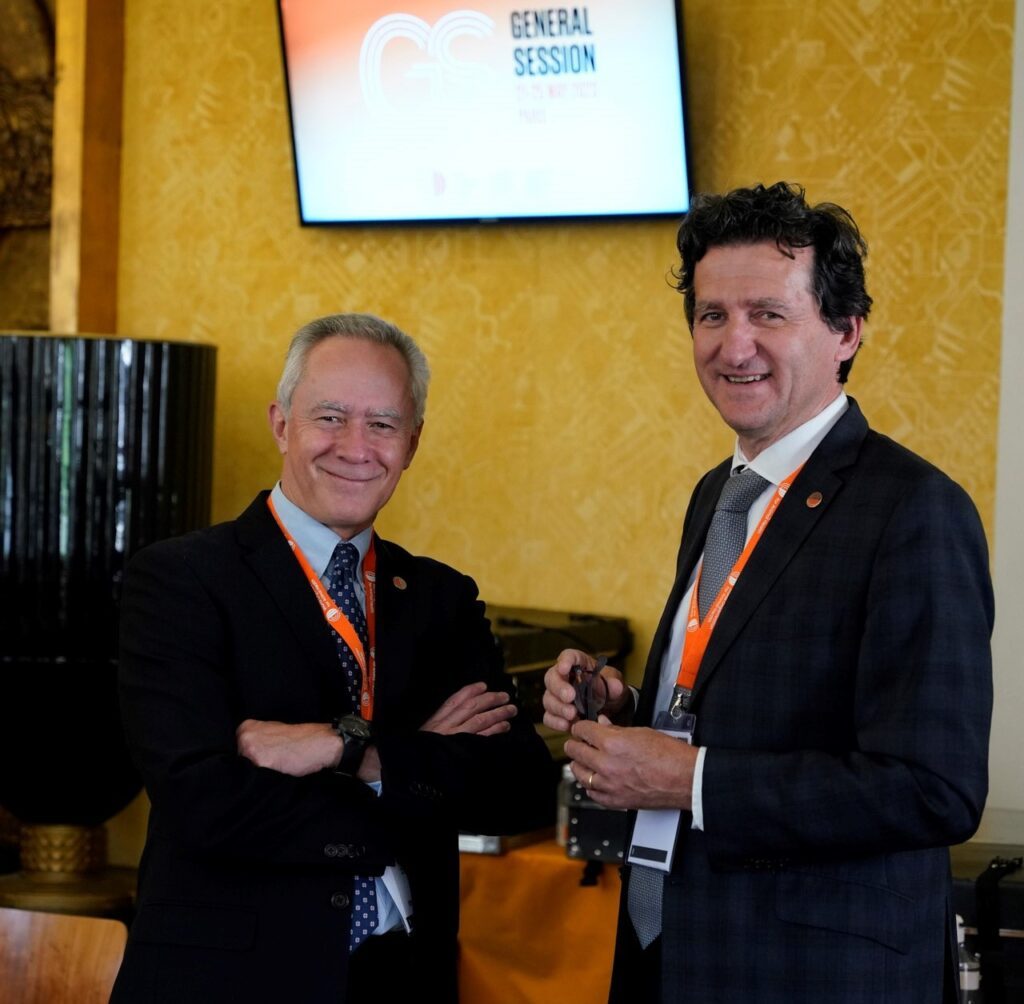
What is the impact of BSE today?
Cristóbal Zepeda: At the beginning of the BSE epidemic in the late 1980s and early 1990s, the majority of cases were detected in a few countries, most predominantly in Europe. Today, the incidence of BSE has dropped to nearly zero, as most countries have implemented measures to avoid the recycling of specified risk materials (SRMs).
Etienne Bonbon: In the past, the uncertainty around the epidemiology of BSE justified an important level of precaution taken to handle the disease. Today, its quasi-zero incidence worldwide minimises the risk of disease and calls for a different level of precaution to face a novel scenario.
What was the rationale for revising the standard on BSE?
C.Z.: The standard on BSE was updated to align it with the current scientific knowledge and an evolving epidemiological context. Several changes were proposed. The first one covers the need for a complete disease risk assessment, including entry and exposure assessments, to determine the risk status of a country or a zone. The second one allows for a simplified surveillance to better match with the reality in the field, while ensuring that minimum sanitary requirements are put in place by countries. Indeed, the cost of implementing a point-based surveillance system is significant and some countries with small cattle populations can simply not comply with such requirements. We have developed guidelines to support countries in the transition to this new system. The last important change is the removal of atypical BSE from the list of diseases which require a compulsory notification to WOAH. Atypical BSE occurs spontaneously in cattle populations at a very low rate. In addition, the only evidence of potential recycling of specified risk materials was found under experimental conditions that would be extremely unlikely to be replicated under field conditions.
E.B.: When talking about the changes brought about by the revised standard on BSE, it is important to note that atypical BSE has been delisted also because it was found to be a very rare and sporadic condition, with no significant impact on animal or public health.
Classical versus atypical BSE
There is a distinction to be made between these two forms, or strains:
Classical BSE occurs through the consumption of contaminated feed. Whilst classical BSE was identified as a significant threat in the 90s, its occurrence has markedly decreased over the past years and is now estimated to be extremely low.
Atypical BSE refers to naturally and sporadically occurring forms, which are believed to occur in all cattle populations at a very low rate, and which have only been identified in older cattle when conducting intensive surveillance. In the early 2000s, atypical prions causing atypical BSE were identified as the result of enhanced surveillance for transmissible spongiform encephalopathies. The number of cases of atypical BSE is negligible. Indeed, whilst to date there is no evidence that atypical BSE plays a significant role in the epidemiology of BSE, the potential for recycling of atypical BSE cannot be ruled out, and therefore measures to manage exposure risk in the feed chain continue to be recommended as a precautionary measure.
What were the challenges along the way?
C.Z.: WOAH has a procedure for official recognition of BSE risk status. In the context of the revision of this standard, we had to ensure that the Members already having an official BSE risk status would still remain compliant with the revised BSE standard. This involved a significant work to retrospectively assess the dossiers submitted by these Members, particularly those that were recognised on the basis of a negligible entry assessment and not a negligible exposure assessment.
E.B.: WOAH strives to find consensus among its Members. The achievement made with the BSE standard is the result of a multi-step process which involved many dedicated expert discussions, extensive consultations with Members, and even a first discussion with the Assembly last year. It shows how the different governance bodies work at the Organisation, and also highlights the role of the Specialist Commissions in the process. These Commissions play a key role to ensure that the standards are scientifically sound, and to build a common understanding trough consultation with Members.
Will the new BSE standard have an impact on the level of surveillance of the disease?
C.Z.: WOAH international standards related to the surveillance of animal diseases – including BSE – are crucial to determining the absence, presence and distribution of animal diseases and related risks, as well as detecting emerging diseases as early as possible. In the current epidemiological context for this disease, there was a growing need among Members to have the standard modified.
E.B.: The justified simplification and cost reduction of surveillance methods will not lead to a reduction in its effectiveness. Rather, this more flexible system based on field clinical screening reflects current scientific information and responds to a diversity of needs across countries.
What will be the impact of this new standard on international trade?
C.Z.: The changes in the surveillance requirements will provide an incentive for countries that have not gained an official risk status to apply for one. By removing atypical BSE as a listed disease, countries will not impose unwarranted trade restrictions.
E.B.: With the adoption of the revised standard, the benefits will be much higher than any risks of disease introduction or emergence. If it is well applied, access to trade will be facilitated thereby accelerating economic development, food security will be improved, while the likelihood of new BSE cases will continue to decrease.
The interview was edited and condensed for clarity and length.
More information
-
bovine spongiform encephalopathy (BSE)
Developed alongside Members and horse industry experts, three equine standards are updated to fight against disease threats and respond to the practical needs of international horse competitions.
Sport and competition horses are seasoned international travellers, hopping from one competition to another across the globe. However, in transit, many can become stuck at the border. International standards are meant to protect the health of the sport horses themselves, as well as a country’s equine population from transmitting diseases across borders. Border controls can prevent sport horses from getting to their competitions on time. Veterinarians and customs officials struggle to find an approach that is fit for purpose, wanting to respect standards that reduce disease risk, and to acknowledge the practical needs of international horse sports.
Seeing an opportunity to support Members, the World Organisation for Animal Health (WOAH) partnered with the horse industry, to find new solutions and ensure the ensure the safety and safe movement of racing and sport horses. WOAH has worked with the International Horse Sports Confederation (IHSC) since 2017 in the framework of a public-private partnership (PPP). Both WOAH and IHSC share clear goals to improve the health and welfare of horses. Namely, to mitigate the risk of the global spread of equine infectious diseases and minimise movement restrictions on competition horses. The collaboration has led to many significant outcomes, with many of the activities leading to the update of three animal health standards, including on equine influenza, contagious equine metritis (CEM), and equine piroplasmosis, presented for adoption at WOAH’s 90th General Session.
WOAH’s international standards are science-based, and the horse industry agreed to contribute with resources to improve the overall quality and accuracy of standards related to horses. This included funding scientific research on horse diseases of concern to international trade. For example, in this study funded by the IHSC-WOAH partnership, a WOAH Reference Laboratory conducted an assessment on equine influenza vaccination protocols for horses before international travel. The horse sector has many vaccination schemes for this virus, and this assessment sought to harmonise current equine influenza schemes based on scientific evidence. This ensures that horses who are being transported are both protected, and that they avoid unjustified waiting periods at their destination. During this assessment, the spirit of collaboration even reached the local level. Private equine veterinarians collected and sent the samples necessary for research and worked with a public research laboratory. Based upon the results of the study, the vaccination protocol to move horses internationally was updated in the standard for Equine Influenza.
The private horse industry around the globe also benefited from this partnership, as WOAH provided its expertise as the international authority on animal health to co-develop tools with IHSC to fit the practical needs of horse sports. Bringing together animal disease experts and horse sport experts, IHSC and WOAH developed two tools to facilitate the international movements of competition horses based on the concepts of zoning and compartmentalisation. The first, the High Health, High Performance (HHP) framework, harmonises importation requirements and simplifies certification process for the temporary movements of horses. The second are guidelines to support Members in the establishment of Equine Disease-Free Zones (EDFZ). This is a risk-based approach which Members can implement when planning an international horse sport competition. By establishing an EDFZ, disease-risks in the zone can be mitigated in advance, and horses may safely enter and exit the zone keeping their health status intact. This lowers the burden of international horse travel for both customs officials and the veterinarian workforce.
The PPP has furthermore addressed the temporary movement of horses at the regional level. A series of joint WOAH-IHSC meetings were held from 2017-2019, involving stakeholders such as veterinary authorities, custom authorities, representatives of the veterinary private sector, and the horse industry. These experts were able to discuss roadblocks to competition horse entry and exit at the border, and create action plans to overcome challenges specific to their regions and national contexts. These activities have led the update of additional standards, including CEM and Equine piroplasmosis.
However, the benefits of this PPP did not stop there. These workshops also served to build networks across private and public functions at the regional level, leading to further collaborations to help solve the future regional challenges. In 2020, an outbreak of African horse sickness (AHS) was reported for the first time in the South-East Asia, including in Thailand who notified the World Animal Health Information System (WAHIS). Responding quickly, WOAH and IHSC provided targeted support by developing dedicated communication materials and producing a series of webinars. Together the PPP built and strengthened the capacity of veterinarians and local horse industry trying to control and eradicate the disease. Furthermore, during the outbreak WOAH and IHSC worked together to enhance the region’s laboratory capabilities by promoting and funding proficiency tests, which ensured that different laboratories were performing to standard and that the personnel and equipment could properly process and analyse disease samples. Since the outbreak, and due in part to the successful collaboration between the horse industry, the public veterinary health sector, and Thailand, they have recovered their AHS free official status since March 2022.
Public-private partnership between WOAH and IHSC has been rich with positive outcomes for all parties, with positive cascading impacts for veterinary authorities, Members and the private equine sector at national level. When different sectors join forces with the common goal of improving animal health globally, the results are indisputable. WOAH relies on these partnerships, knowing that our activities cannot operate and evolve without the continuous exchange of information and resources. Using science, WOAH and its partners were able to update international standards, to ensure the safe and healthy travel of competition horses, and ensure that border controls are improved, efficient and able to apply science-based approaches. This model gives hope for future partnerships, allowing WOAH to strengthen ties with the private sector stakeholders on other pertinent animal health and welfare challenges. Because animal health should not be only a concern for only one sector. Only together can we ensure a healthier future for all.

